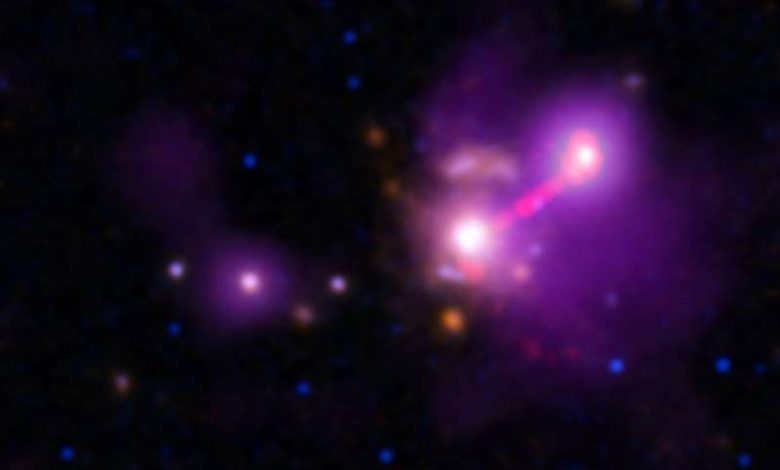Astronomers observe lone distant galaxy that appears to have consumed all of its former companions

Over 13 billion years ago, the first galaxies in the universe formed. They were elliptical, with intermediate black holes (IMBHs) at their centers surrounded by a halo of stars, gas, and dust.
Over time, these galaxies evolved by flattening out into disks with a large bulge in the middle. They were then drawn together by mutual gravitational attraction to form galaxy clusters, massive collections that comprise the large-scale cosmic structure. This force of attraction also led to mergers, where galaxies and their central black holes came together to create larger spiral galaxies with central supermassive black holes (SMBHs).
This process of mergers and assimilation (and their role in galactic evolution) is still a mystery to astronomers today since much of it took place during the early universe, which is still very difficult to observe with existing telescopes. Using data from NASA’s Chandra X-ray Observatory and the International Gemini Observatory, an international team of astronomers observed a lone distant galaxy that appears to have consumed all of its former companions. Their findings, which recently appeared in The Astrophysical Journal, suggest galaxies in the early universe grew faster than previously thought.
The research team was led by Valentina Missaglia, a postdoctoral astrophysicist at the University of Turin. She was joined by colleagues from the National Nuclear Physics Institute (INFN), the Astrophysical Observatory of Turin, The University of Texas Rio Grande Valley, the Max Planck Institute for Astronomy (MPIA), the Brazil Ministry of Science, Technology, Innovation, and Communication (MCTIC), the Instituto Nacional de Pesquisas Espaciais (INPE), the Harvard & Smithsonian Center for Astrophysics, Institute of Theoretical and Experimental Astronomy (IATE), and the National Institute of Astrophysics (INAF).
The team reported the unexpected discovery of a solo galaxy (3C 297) about 9.2 billion light-years away. They also noted that it contained a quasar at its center and powerful jets (bright in the radio spectrum) emanating from its poles. The environment of this galaxy appears to have several key features of a galaxy cluster; nevertheless, the galaxy appears to be alone. As Missaglia said in a Harvard-Chandra press release, “It seems that we have a galaxy cluster that is missing almost all of its galaxies,” she said. “We expected to see at least a dozen galaxies about the size of the Milky Way, yet we see only one.”
Missaglia and her colleagues noted three features associated with galaxy clusters based on the Chandra data. First, the X-ray data revealed that 3C 297 is surrounded by large quantities of high-temperature gas (tens of millions of degrees)—something rarely seen outside of galaxy clusters. Second, the relativistic jet streaming from its SMBH created a bright X-ray source about 140,000 light-years away, which implied it had pushed through gas surrounding the galaxy. Third, one of the radio jets appeared bent, indicating it was interacting with its surroundings.
This last finding was previously observed based on data collected by the Karl G. Jansky Very Large Array (VLA). But when the team consulted their data from the Gemini Observatory, they noticed that none of the 19 galaxies that appeared close to 3C 297 were actually at the same distance. Said co-author Juan Madrid, an assistant professor at the University of Texas Rio Grande Valley:
“The question is, what happened to all of these galaxies? We think the gravitational pull of the one large galaxy combined with interactions between the galaxies was too strong, and they merged with the large galaxy. For these galaxies, apparently, resistance was futile.”
While the authors cannot rule out the possibility of dwarf galaxies located around 3C 297, their presence would still not explain why no larger galaxies are nearby. In addition, they anticipate that 3C 297 will spend several billion years on its own before it gains any large galactic companions (like M87 and the Virgo Cluster). While it is not clear how 3C 297 ended up on its own in a cluster-like environment, the team theorizes that it could be a “fossil group”—the end stage of a galaxy merging with several others.
While many other fossil groups have been detected before, at 9.2 billion light-years distant, this one is the most distant ever seen. The previous record holders for fossil groups were 4.9 and 7.9 billion light-years away (respectively). “It may be challenging to explain how the universe can create this system only 4.6 billion years after the Big Bang,” said co-author Mischa Schirmer of the MPIA. “This doesn’t break our ideas of cosmology, but it begins to push the limits on how quickly both galaxies and galaxy clusters must have formed.”





